Unit1 People of Achievement Learning About Language课件(共28张PPT)-2025-2026学年人教版(2019)选择性必修第一册
文档属性
| 名称 | Unit1 People of Achievement Learning About Language课件(共28张PPT)-2025-2026学年人教版(2019)选择性必修第一册 | 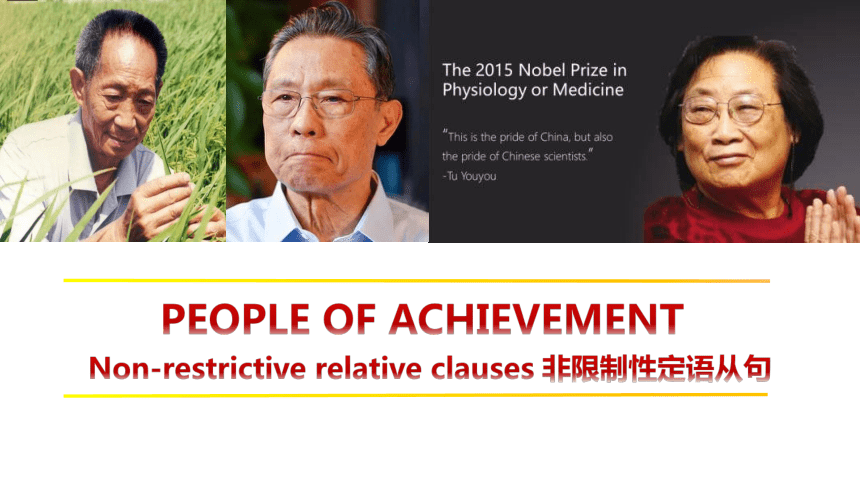 | |
| 格式 | pptx | ||
| 文件大小 | 8.6MB | ||
| 资源类型 | 教案 | ||
| 版本资源 | 人教版(2019) | ||
| 科目 | 英语 | ||
| 更新时间 | 2025-06-21 00:15:00 | ||
图片预览

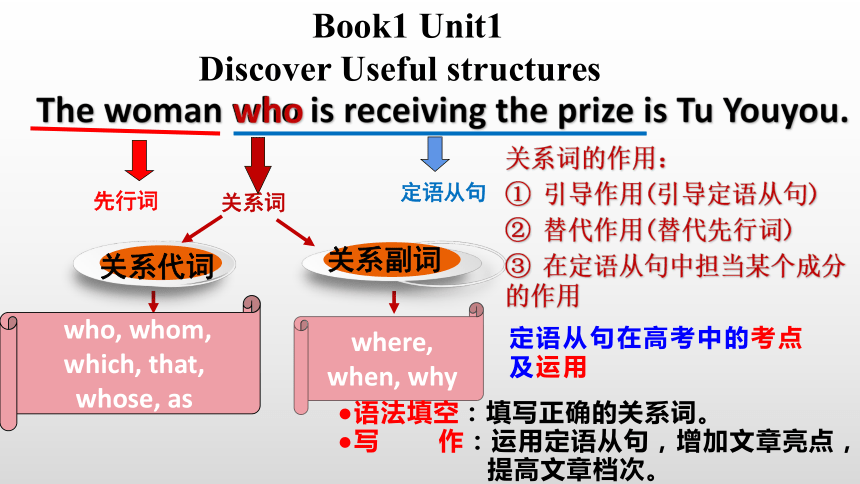

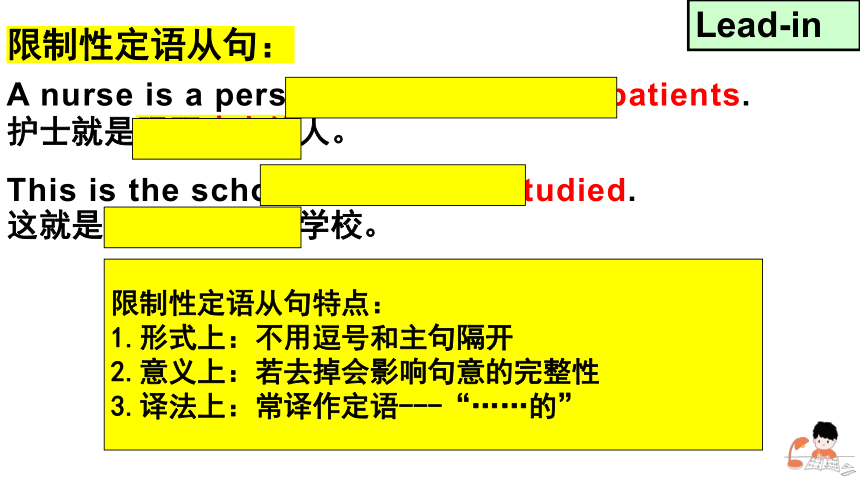
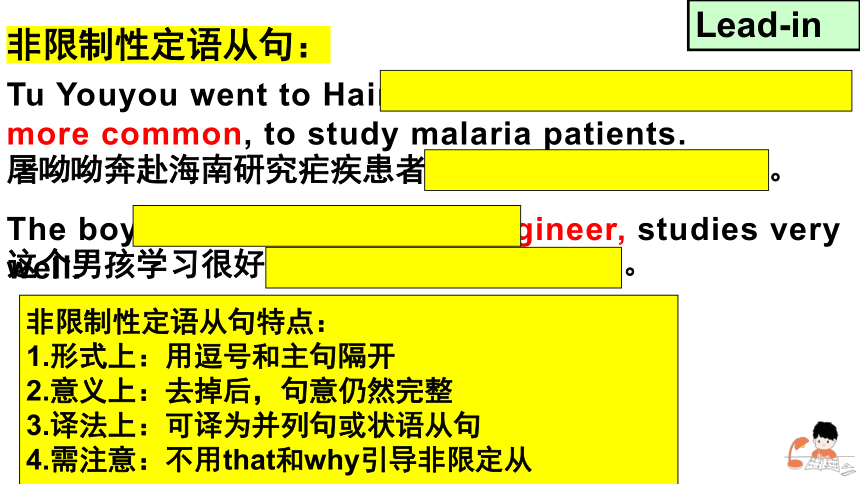
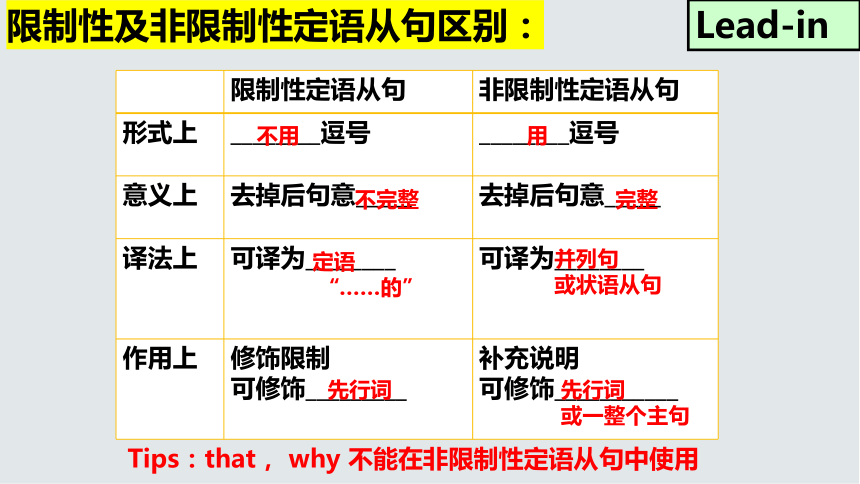
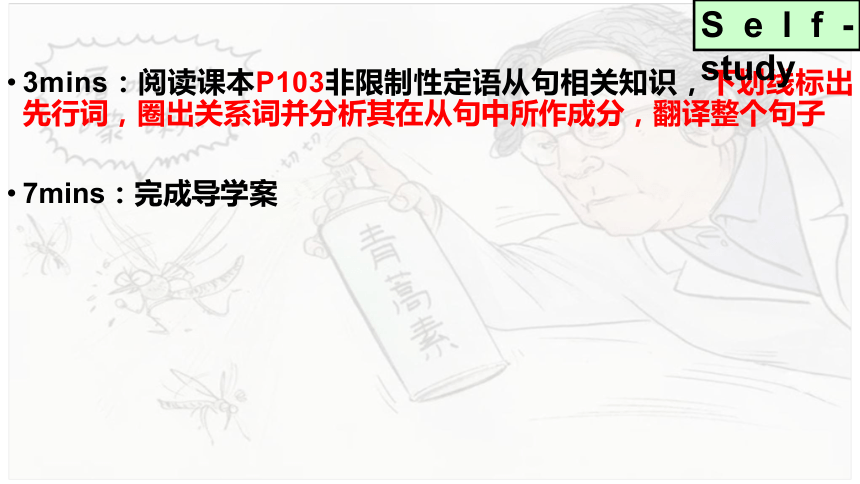
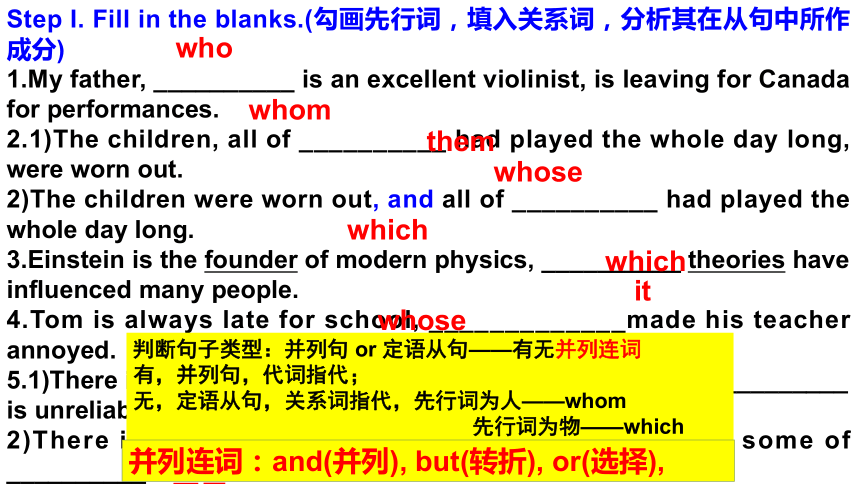
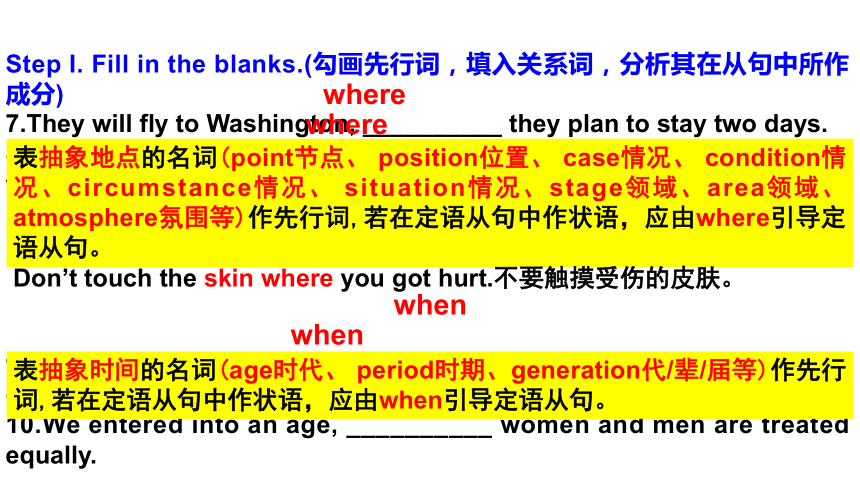
文档简介
(共28张PPT)
PEOPLE OF ACHIEVEMENT
Non-restrictive relative clauses 非限制性定语从句
The woman who is receiving the prize is Tu Youyou.
先行词
关系词
定语从句
who
关系代词
关系副词
who, whom, which, that, whose, as
where, when, why
关系词的作用:
① 引导作用(引导定语从句)
② 替代作用(替代先行词)
③ 在定语从句中担当某个成分的作用
Book1 Unit1
Discover Useful structures
定语从句在高考中的考点及运用
语法填空:填写正确的关系词。
写 作:运用定语从句,增加文章亮点,
提高文章档次。
限制性定语从句:
He doesn’t wear a piece of clothing which is strange.
非限制性定语从句:
He doesn’t wear a piece of clothing, which is strange.
他不穿奇怪的衣服。
他不穿衣服,这很奇怪。
如何区分?
Lead-in
限制性定语从句:
A nurse is a person who looks after patients.
This is the school where Tom studied.
护士就是照顾病人的人。
这就是汤姆学习过的学校。
限制性定语从句特点:
1.形式上:不用逗号和主句隔开
2.意义上:若去掉会影响句意的完整性
3.译法上:常译作定语---“……的”
Lead-in
非限制性定语从句:
Tu Youyou went to Hainan, where malaria was more common, to study malaria patients.
The boy, whose father is an engineer, studies very well.
屠呦呦奔赴海南研究疟疾患者,在那里疟疾更为常见 。
这个男孩学习很好,他的爸爸是一名工程师。
非限制性定语从句特点:
1.形式上:用逗号和主句隔开
2.意义上:去掉后,句意仍然完整
3.译法上:可译为并列句或状语从句
4.需注意:不用that和why引导非限定从
Lead-in
Lead-in
限制性定语从句 非限制性定语从句
形式上 ________逗号 ________逗号
意义上 去掉后句意_____ 去掉后句意_____
译法上 可译为________ 可译为________
作用上 修饰限制 可修饰_________ 补充说明
可修饰___________
不完整
不用
用
完整
先行词
或一整个主句
先行词
定语
“……的”
并列句
或状语从句
Tips:that, why 不能在非限制性定语从句中使用
限制性及非限制性定语从句区别:
3mins:阅读课本P103非限制性定语从句相关知识,下划线标出先行词,圈出关系词并分析其在从句中所作成分,翻译整个句子
7mins:完成导学案
Self-study
Step I. Fill in the blanks.(勾画先行词,填入关系词,分析其在从句中所作成分)
1.My father, __________ is an excellent violinist, is leaving for Canada for performances.
2.1)The children, all of __________ had played the whole day long, were worn out.
2)The children were worn out, and all of __________ had played the whole day long.
3.Einstein is the founder of modern physics, __________ theories have influenced many people.
4.Tom is always late for school, _____________made his teacher annoyed.
5.1)There is too much information on the Internet, some of __________ is unreliable.
2)There is too much information on the Internet, and some of __________ is unreliable.
6. Her mother works in a company, ______________employees(雇员) are all women.
them
whom
who
whose
which
which
it
whose
判断句子类型:并列句 or 定语从句——有无并列连词
有,并列句,代词指代;
无,定语从句,关系词指代,先行词为人——whom
先行词为物——which
并列连词:and(并列), but(转折), or(选择), so(因果)
Step I. Fill in the blanks.(勾画先行词,填入关系词,分析其在从句中所作成分)
7.They will fly to Washington, __________ they plan to stay two days.
8.I can’t imagine a situation, __________ I would be quarreling with her there.
9.Our graduation will be held in July, __________ we’ll say goodbye to our teachers.
10.We entered into an age, __________ women and men are treated equally.
when
where
where
when
表抽象地点的名词(point节点、 position位置、 case情况、 condition情况、circumstance情况、 situation情况、stage领域、area领域、atmosphere氛围等)作先行词,若在定语从句中作状语,应由where引导定语从句。
Don’t touch the skin where you got hurt.不要触摸受伤的皮肤。
表抽象时间的名词(age时代、 period时期、generation代/辈/届等)作先行词,若在定语从句中作状语,应由when引导定语从句。
Step I. Fill in the blanks.(勾画先行词,填入关系词,分析其在从句中所作成分)
11.1)______ everybody knows, J.K. Rowling is a famous novelist.
2)Tom is a brave boy, ______ is often the case.
3)The project, _______ was mentioned above, got along well.
总结:as也可引导非限定从,先行词就是_______________,它在定从中作______、______。它引导的从句可以位于主句前、主句后及主句中间。
as
as
As
整个主句
主语 宾语
as固定搭配:
as is known to all众所周知
as is often the case情况常常如此
as is said above如上所述
as is reported正如报道的那样
as is mentioned正如所提及的那样
as we all know众所周知
as we expected正如我们预料的
语填:
This year, I have been living in Quebec, a province of eastern Canada. When I first arrived, the thing I was most scared about was the winter. What would it be like to have three metres of snow ... _3____________ you might expect, I needn’t have worried.
As
Step II. Translate the following sentences. (使用非限定从)
1.北京四季分明,其中秋天是最适合参观的季节。
Beijing has four distinct seasons, among which autumn is the best season to visit.
2.【演讲稿】很荣幸能站在这里演讲,我演讲的题目是“我最钦佩的人”。
It’s my great honor to stand here to give a speech, whose topic/ the topic of which is “The Person I Admire Most.”
3.众所周知,尊老爱幼是中国的优良传统。
As we all know, respecting the old and taking care of the young is a good Chinese tradition.
4.中秋节是中国最受欢迎的传统节日之一,它适逢于每年的八月十五//在那时中国人们一起赏月、吃月饼。
Mid Autumn Festival is a traditional festival in China, which falls on the 15th day of the 8th month on the Chinese lunar calendar, when people get together to admire the moon and eat the mooncake.
Exercises
1. They tested hundreds of Chinese medical treatments that showed promise in the fight against the disease.
2. Tu Youyou was awarded the Nobel Prize, which is considered one of the highest international honours a person can receive.
3. Tu Youyou went to Hainan, where malaria was more common, to study malaria patients.
4. Later, the medicine was tested on malaria patients, most of whom recovered.
Read the following sentences and underline the relative clauses. Then name the two types of clauses and state their functions. P5 EX.1
restrictive relative clauses
non-restrictive relative clauses
non-restrictive relative clauses
non-restrictive relative clauses
Rewrite the sentences using non-restrictive relative clauses.P5 EX.2
Exercises
Rewrite the sentences using non-restrictive relative clauses. How do the sentences flow differently?
1. We were very impressed by the old man. He was not willing to acknowledge defeat.
2. Afterwards, Einstein had to flee Germany. Hitler was in power there.
We were very impressed by the old man, who was not willing to acknowledge defeat.
Afterwards, Einstein had to flee Germany, where(=in Germany) Hitler was in power.
the old man
Germany
there
He
Exercises
Rewrite the sentences using non-restrictive relative clauses. How do the sentences flow differently?
3. There is nothing we can do to help Linda. Her circumstances are beyond our control.
4. The teacher asked us to listen to a speech by his favorite novelist, J.K. Rowling. It inspired us a lot.
There is nothing we can do to help Linda, whose circumstances are beyond our control.
The teacher asked us to listen to a speech by his favorite novelist, J.K. Rowling, which inspired us a lot.
5 The building under construction was designed by I.M. Pei—a famous Chinese-American architect. He was born in Guangzhou, China.
6 I was asked to explain the project with the help of a flow chart. It was a big challenge for me.
Exercises
Rewrite the sentences using non-restrictive relative clauses. How do the sentences flow differently?
The building under construction was designed by I.M. Pei—a famous Chinese-American architect, who was born in Guangzhou, China.
I was asked to explain the project with the help of a flow chart, which it was a big challenge for me.
a flow chart
It
Workbook: Using StructuresP62
1 Some people always talk loudly in public, _______ is really annoying.
2 Mr Smith, _______________you spoke to, is our new professor.
3 Please come back at four o'clock,_______your herbal medicine will be ready.
4 What do you want to write about these people, _______stories I have just told you
who whom which
whose when where
in/of/for which of whom
1. Choose the words in the box to complete the sentences.
which
who/whom
when
whose
Using Structures
5 Have you been to the Louvre Museum, _____________you can see the Mona Lisa on display
6 There are 45 students in our class, out_______ only 10 are taking an optional art course.
7 Her mother works in a company,______________ employees are all women.
8 It is vital to learn to use these software programmes, both _________can help you with collection and evaluation.
where/in which
of whom
in which/where
of which
Workbook Using Structures
2 Decide whether the sentences are right or wrong. Correct them where necessary.
1 Please write down these phrases, all of them will be useful in your writing.
2 Asa consequence of sending in his application late, he did not get a patent for his invention, that was not surprising at all.
which
which
Workbook Using Structures
3 The researchers are evaluating thousands of plants, which have distinct medical properties.
4 The gentle old man is the only person, whom I can trust.
5 Have you done all what you can to help the people in need
6 Is this the botanical institute where you visited last week
that
which / that
Workbook Using Structures
3 Write a few sentences about some great people with the information given below.Use relative clauses.
Song Qingling, who was Dr Sun Yat-sen’s wife and one of the top leaders in modern Chinese history, devoted her life to improving the welfare of women and children.
Neil Armstrong, who was the first man to land on the moon in July 1969, said,“That's a small step for (a) man, one giant leap for mankind.”
Norman Bethune, who came to China in World War II, worked selflessly in China as a doctor and saved many Chinese people.
Lu Xun was a leading figure of modern Chinese literature.Lu Xun Literary Prize, which is one of China's top four literary prizesis awarded every three years.
Joan of Arc, who was a girl dressed as a man, went to fight for her country. She helped drive the English invaders out of France.
1.1)I can never forget the days ________ we worked together.
2)I can never forget the days during ________ we worked together.
3)Don’t forget the days ___________ I spent with you.
2.1)This is the village ________ he was born.
2)This is the village in ________ he was born.
3)This is the village ___________ attracted us greatly.
3.1)We don’t know the reason ________ he didn’t show up.
2)We don’t know the reason for ________ he didn’t show up.
3)The reason ___________ they told you isn’t true.
限定从-勾画先行词,填入关系词,分析其在从句中所作成分
when
which
that/which
where
which
why
which
that/which
that/which
4.This is the most precious gift __________ I have ever received.
5.I’m painting a house __________ roof is round.
6.There are a number of differences in the way __________ children and adults think.
7.This is the second time __________ he has been late for class.
8.She is one of the students who __________(be) late.
9.The car _______________(repair) is mine.
10.Most of the artists __________(invite) to the party were from Japan.
限定从-特殊
that
whose
that/in which/-
that/-
are
invited
(being) repaired
1.I remember
2.This is the book
3.The colorless gas __________ which we cannot live is called oxygen.
the day __________ which I settled in China.
the days __________ which I lived here.
the month __________ which I stayed there.
__________ which I spent 5 yuan.
__________ which I paid 5 yuan.
__________ which I learnt a lot.
__________ which Jack often talks.
on
during
in
on
for
from
about
without
“介词+关系代词”引导的定语从句中介词的选择依据:
一先(根据先行词)、二动(根据从句谓动的搭配)、三意义(根据句意)
1.Tu Youyou is a successful female scientist, __________ has been awarded the Nobel Prize for Physiology or Medicine.
2.1)Mr Li has three daughters, none of __________ is an engineer.
2)Mr Li has three daughters, but none of __________ is a dancer.
3.1)He arrived in Beijing in 1984, __________ was important for him.
2)He arrived in Beijing in 1984, __________ he became a manager 2 years later.
3)He arrived in Beijing in 1984, __________ he was already in his fifties.
4)It was in 1984 __________ he arrived in Beijing.
4.__________ is known to us all, the moon travels around the earth.
5.They live in a room, __________ window opens to the south.
who
which
when
where
that
As
whom
them
whose
非限定从-勾画先行词,填入关系词,分析其在从句中所作成分
指人 指物 在定语从句中所作成分 who √ 主语
whom √ 宾语
which √(或指代整个主句) 主语 宾语
as √ √(或指代整个主句) 主语 宾语
whose √ √ 定语 指地点 指时间 在定语从句中所作成分
where √ 状语
when √ 状语
Tips:that, why 不能在非限制性定语从句中使用 关系副词
关系代词
非限制性定语从句中的关系词:
THANK YOU
PEOPLE OF ACHIEVEMENT
Non-restrictive relative clauses 非限制性定语从句
The woman who is receiving the prize is Tu Youyou.
先行词
关系词
定语从句
who
关系代词
关系副词
who, whom, which, that, whose, as
where, when, why
关系词的作用:
① 引导作用(引导定语从句)
② 替代作用(替代先行词)
③ 在定语从句中担当某个成分的作用
Book1 Unit1
Discover Useful structures
定语从句在高考中的考点及运用
语法填空:填写正确的关系词。
写 作:运用定语从句,增加文章亮点,
提高文章档次。
限制性定语从句:
He doesn’t wear a piece of clothing which is strange.
非限制性定语从句:
He doesn’t wear a piece of clothing, which is strange.
他不穿奇怪的衣服。
他不穿衣服,这很奇怪。
如何区分?
Lead-in
限制性定语从句:
A nurse is a person who looks after patients.
This is the school where Tom studied.
护士就是照顾病人的人。
这就是汤姆学习过的学校。
限制性定语从句特点:
1.形式上:不用逗号和主句隔开
2.意义上:若去掉会影响句意的完整性
3.译法上:常译作定语---“……的”
Lead-in
非限制性定语从句:
Tu Youyou went to Hainan, where malaria was more common, to study malaria patients.
The boy, whose father is an engineer, studies very well.
屠呦呦奔赴海南研究疟疾患者,在那里疟疾更为常见 。
这个男孩学习很好,他的爸爸是一名工程师。
非限制性定语从句特点:
1.形式上:用逗号和主句隔开
2.意义上:去掉后,句意仍然完整
3.译法上:可译为并列句或状语从句
4.需注意:不用that和why引导非限定从
Lead-in
Lead-in
限制性定语从句 非限制性定语从句
形式上 ________逗号 ________逗号
意义上 去掉后句意_____ 去掉后句意_____
译法上 可译为________ 可译为________
作用上 修饰限制 可修饰_________ 补充说明
可修饰___________
不完整
不用
用
完整
先行词
或一整个主句
先行词
定语
“……的”
并列句
或状语从句
Tips:that, why 不能在非限制性定语从句中使用
限制性及非限制性定语从句区别:
3mins:阅读课本P103非限制性定语从句相关知识,下划线标出先行词,圈出关系词并分析其在从句中所作成分,翻译整个句子
7mins:完成导学案
Self-study
Step I. Fill in the blanks.(勾画先行词,填入关系词,分析其在从句中所作成分)
1.My father, __________ is an excellent violinist, is leaving for Canada for performances.
2.1)The children, all of __________ had played the whole day long, were worn out.
2)The children were worn out, and all of __________ had played the whole day long.
3.Einstein is the founder of modern physics, __________ theories have influenced many people.
4.Tom is always late for school, _____________made his teacher annoyed.
5.1)There is too much information on the Internet, some of __________ is unreliable.
2)There is too much information on the Internet, and some of __________ is unreliable.
6. Her mother works in a company, ______________employees(雇员) are all women.
them
whom
who
whose
which
which
it
whose
判断句子类型:并列句 or 定语从句——有无并列连词
有,并列句,代词指代;
无,定语从句,关系词指代,先行词为人——whom
先行词为物——which
并列连词:and(并列), but(转折), or(选择), so(因果)
Step I. Fill in the blanks.(勾画先行词,填入关系词,分析其在从句中所作成分)
7.They will fly to Washington, __________ they plan to stay two days.
8.I can’t imagine a situation, __________ I would be quarreling with her there.
9.Our graduation will be held in July, __________ we’ll say goodbye to our teachers.
10.We entered into an age, __________ women and men are treated equally.
when
where
where
when
表抽象地点的名词(point节点、 position位置、 case情况、 condition情况、circumstance情况、 situation情况、stage领域、area领域、atmosphere氛围等)作先行词,若在定语从句中作状语,应由where引导定语从句。
Don’t touch the skin where you got hurt.不要触摸受伤的皮肤。
表抽象时间的名词(age时代、 period时期、generation代/辈/届等)作先行词,若在定语从句中作状语,应由when引导定语从句。
Step I. Fill in the blanks.(勾画先行词,填入关系词,分析其在从句中所作成分)
11.1)______ everybody knows, J.K. Rowling is a famous novelist.
2)Tom is a brave boy, ______ is often the case.
3)The project, _______ was mentioned above, got along well.
总结:as也可引导非限定从,先行词就是_______________,它在定从中作______、______。它引导的从句可以位于主句前、主句后及主句中间。
as
as
As
整个主句
主语 宾语
as固定搭配:
as is known to all众所周知
as is often the case情况常常如此
as is said above如上所述
as is reported正如报道的那样
as is mentioned正如所提及的那样
as we all know众所周知
as we expected正如我们预料的
语填:
This year, I have been living in Quebec, a province of eastern Canada. When I first arrived, the thing I was most scared about was the winter. What would it be like to have three metres of snow ... _3____________ you might expect, I needn’t have worried.
As
Step II. Translate the following sentences. (使用非限定从)
1.北京四季分明,其中秋天是最适合参观的季节。
Beijing has four distinct seasons, among which autumn is the best season to visit.
2.【演讲稿】很荣幸能站在这里演讲,我演讲的题目是“我最钦佩的人”。
It’s my great honor to stand here to give a speech, whose topic/ the topic of which is “The Person I Admire Most.”
3.众所周知,尊老爱幼是中国的优良传统。
As we all know, respecting the old and taking care of the young is a good Chinese tradition.
4.中秋节是中国最受欢迎的传统节日之一,它适逢于每年的八月十五//在那时中国人们一起赏月、吃月饼。
Mid Autumn Festival is a traditional festival in China, which falls on the 15th day of the 8th month on the Chinese lunar calendar, when people get together to admire the moon and eat the mooncake.
Exercises
1. They tested hundreds of Chinese medical treatments that showed promise in the fight against the disease.
2. Tu Youyou was awarded the Nobel Prize, which is considered one of the highest international honours a person can receive.
3. Tu Youyou went to Hainan, where malaria was more common, to study malaria patients.
4. Later, the medicine was tested on malaria patients, most of whom recovered.
Read the following sentences and underline the relative clauses. Then name the two types of clauses and state their functions. P5 EX.1
restrictive relative clauses
non-restrictive relative clauses
non-restrictive relative clauses
non-restrictive relative clauses
Rewrite the sentences using non-restrictive relative clauses.P5 EX.2
Exercises
Rewrite the sentences using non-restrictive relative clauses. How do the sentences flow differently?
1. We were very impressed by the old man. He was not willing to acknowledge defeat.
2. Afterwards, Einstein had to flee Germany. Hitler was in power there.
We were very impressed by the old man, who was not willing to acknowledge defeat.
Afterwards, Einstein had to flee Germany, where(=in Germany) Hitler was in power.
the old man
Germany
there
He
Exercises
Rewrite the sentences using non-restrictive relative clauses. How do the sentences flow differently?
3. There is nothing we can do to help Linda. Her circumstances are beyond our control.
4. The teacher asked us to listen to a speech by his favorite novelist, J.K. Rowling. It inspired us a lot.
There is nothing we can do to help Linda, whose circumstances are beyond our control.
The teacher asked us to listen to a speech by his favorite novelist, J.K. Rowling, which inspired us a lot.
5 The building under construction was designed by I.M. Pei—a famous Chinese-American architect. He was born in Guangzhou, China.
6 I was asked to explain the project with the help of a flow chart. It was a big challenge for me.
Exercises
Rewrite the sentences using non-restrictive relative clauses. How do the sentences flow differently?
The building under construction was designed by I.M. Pei—a famous Chinese-American architect, who was born in Guangzhou, China.
I was asked to explain the project with the help of a flow chart, which it was a big challenge for me.
a flow chart
It
Workbook: Using StructuresP62
1 Some people always talk loudly in public, _______ is really annoying.
2 Mr Smith, _______________you spoke to, is our new professor.
3 Please come back at four o'clock,_______your herbal medicine will be ready.
4 What do you want to write about these people, _______stories I have just told you
who whom which
whose when where
in/of/for which of whom
1. Choose the words in the box to complete the sentences.
which
who/whom
when
whose
Using Structures
5 Have you been to the Louvre Museum, _____________you can see the Mona Lisa on display
6 There are 45 students in our class, out_______ only 10 are taking an optional art course.
7 Her mother works in a company,______________ employees are all women.
8 It is vital to learn to use these software programmes, both _________can help you with collection and evaluation.
where/in which
of whom
in which/where
of which
Workbook Using Structures
2 Decide whether the sentences are right or wrong. Correct them where necessary.
1 Please write down these phrases, all of them will be useful in your writing.
2 Asa consequence of sending in his application late, he did not get a patent for his invention, that was not surprising at all.
which
which
Workbook Using Structures
3 The researchers are evaluating thousands of plants, which have distinct medical properties.
4 The gentle old man is the only person, whom I can trust.
5 Have you done all what you can to help the people in need
6 Is this the botanical institute where you visited last week
that
which / that
Workbook Using Structures
3 Write a few sentences about some great people with the information given below.Use relative clauses.
Song Qingling, who was Dr Sun Yat-sen’s wife and one of the top leaders in modern Chinese history, devoted her life to improving the welfare of women and children.
Neil Armstrong, who was the first man to land on the moon in July 1969, said,“That's a small step for (a) man, one giant leap for mankind.”
Norman Bethune, who came to China in World War II, worked selflessly in China as a doctor and saved many Chinese people.
Lu Xun was a leading figure of modern Chinese literature.Lu Xun Literary Prize, which is one of China's top four literary prizesis awarded every three years.
Joan of Arc, who was a girl dressed as a man, went to fight for her country. She helped drive the English invaders out of France.
1.1)I can never forget the days ________ we worked together.
2)I can never forget the days during ________ we worked together.
3)Don’t forget the days ___________ I spent with you.
2.1)This is the village ________ he was born.
2)This is the village in ________ he was born.
3)This is the village ___________ attracted us greatly.
3.1)We don’t know the reason ________ he didn’t show up.
2)We don’t know the reason for ________ he didn’t show up.
3)The reason ___________ they told you isn’t true.
限定从-勾画先行词,填入关系词,分析其在从句中所作成分
when
which
that/which
where
which
why
which
that/which
that/which
4.This is the most precious gift __________ I have ever received.
5.I’m painting a house __________ roof is round.
6.There are a number of differences in the way __________ children and adults think.
7.This is the second time __________ he has been late for class.
8.She is one of the students who __________(be) late.
9.The car _______________(repair) is mine.
10.Most of the artists __________(invite) to the party were from Japan.
限定从-特殊
that
whose
that/in which/-
that/-
are
invited
(being) repaired
1.I remember
2.This is the book
3.The colorless gas __________ which we cannot live is called oxygen.
the day __________ which I settled in China.
the days __________ which I lived here.
the month __________ which I stayed there.
__________ which I spent 5 yuan.
__________ which I paid 5 yuan.
__________ which I learnt a lot.
__________ which Jack often talks.
on
during
in
on
for
from
about
without
“介词+关系代词”引导的定语从句中介词的选择依据:
一先(根据先行词)、二动(根据从句谓动的搭配)、三意义(根据句意)
1.Tu Youyou is a successful female scientist, __________ has been awarded the Nobel Prize for Physiology or Medicine.
2.1)Mr Li has three daughters, none of __________ is an engineer.
2)Mr Li has three daughters, but none of __________ is a dancer.
3.1)He arrived in Beijing in 1984, __________ was important for him.
2)He arrived in Beijing in 1984, __________ he became a manager 2 years later.
3)He arrived in Beijing in 1984, __________ he was already in his fifties.
4)It was in 1984 __________ he arrived in Beijing.
4.__________ is known to us all, the moon travels around the earth.
5.They live in a room, __________ window opens to the south.
who
which
when
where
that
As
whom
them
whose
非限定从-勾画先行词,填入关系词,分析其在从句中所作成分
指人 指物 在定语从句中所作成分 who √ 主语
whom √ 宾语
which √(或指代整个主句) 主语 宾语
as √ √(或指代整个主句) 主语 宾语
whose √ √ 定语 指地点 指时间 在定语从句中所作成分
where √ 状语
when √ 状语
Tips:that, why 不能在非限制性定语从句中使用 关系副词
关系代词
非限制性定语从句中的关系词:
THANK YOU
